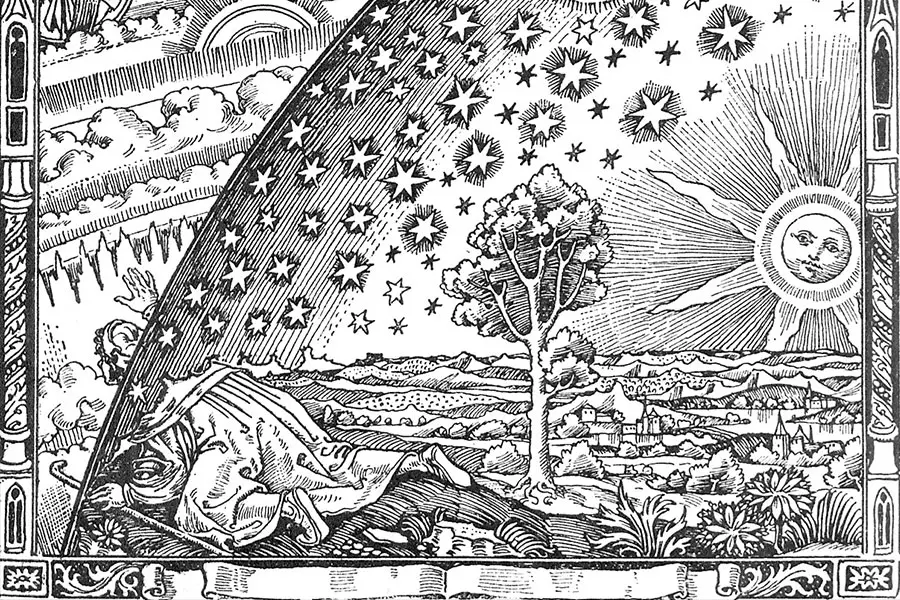The phrase As Above, So Below is one that evokes contemplation when heard, but when pondered upon for a moment can be confusing. It is an ancient phrase, rich in meaning and history. In this article we are going to try to answer the question: what does as above so below mean?
The phrase As Above, So Below means that our reality, our lived experiences, and our existence, are part of an infinite fractal pattern. It describes the correspondent relationship between the individual and the universe. The phrase comes from Hermeticism, in particle a book called The Emerald Tablets, which dates to thousands of years ago.

The Microcosm and Macrocosm Relationship
In Hermetic philosophy there is the microcosm, the word of the individual, and the macrocosm, which is the universe, or the sum total of all that is.
The word macrocosm comes from Greek makros kosmos, “the great world”; the universe as a whole. Microcosm comes from Greek mikros kosmos, “the small world”; the human being, understood as a miniature universe)
In other words, the phrase can be interpreted to say that “Above” is referring to nature and the cosmos, and the “Below” part refers to what happens inside of us as humans, or our personal subjective experience of being alive. The microcosm – macrocosm relationship is wonderfully described in the following quote:
“To truly know the world, look deeply within your own being, To truly know yourself, take real interest in the world.” ~ Rudolf Steiner
This relational dynamic can be seen anywhere there is duality, where one half is above, and the other below, and there is an established relationship between the two.
Hermeticism
Hermeticism is a system of philosophy based on the teachings of Hermes Trismegistus, and was very prominent during the Renaissance and Reformation periods of history. When it was realized that the Egyptian god Thoth and the Greek god Hermes were the same being, he started being referred to as Hermes Trismegistus. The written works of Hermeticism were created over many decades, from 300 B.C to 1200 A.D.

The Emerald Tablets
The Specific origin of the phrase As Above, So Below originates from the second verse of a book called the Emerald Tablets, also known as Smaragdine Tablet and Tabula Smaragdina. Purported to have been authored by Hermes Trismegistus, it is one of the most famous and important books in Hermeticism, along with Hermetic Corpus, which is the foundation text for Hermeticism. While Hermes is considered the author, the first known version of it, according to historians, appears in Arabic somewhere around the 6th to 8th century A.D.
As Above, So Below in Alchemy
The Emerald Tablet are very important in alchemy because it describes the prima materia, which is the starting material for all matter. The concept of prima materia is a crucial concept in alchemical thinking.
Scholarly Perspectives
Amongst scholars, the phrase is often understood to be referring to the effects of celestial mechanics upon terrestrial events. This can be materialistic in nature, such as the effect of the sun on the plants growing on earth, but it can also be esoteric or non-physical in nature. When studying the phrase, the version most commonly looked at is the medieval Latin translation:
“Quod est superius est sicut quod inferius, et quod inferius est sicut quod est superius.”
“That which is above is like to that which is below, and that which is below is like to that which is above.”
This Latin version differs from the original Arabic is a little different, which says “from” rather than “like to”.
One of the most well-known translations was done by Isaac Newton. In the Isaac Newton version, the phrases appear written like: “that which is below is like that which is above and that which is above is like that which is below”.
Modern science has confirmed the concept of As Above, So Below as it has been able to observe galaxies of space, as well as the world of atomic particles, and found surprising similarities between the two. Both consist of particles kept in orbit by the gravity of an energetic core. In this way modern science has confirmed the wisdom of ancient thought.
Helena P. Blavatsky and the Occult Perspective
The phrase in many ways has been popularized by the occult crowd in recent times, who generally view it as being in reference to the correspondence of different planes of existence. Blavatsky and others built upon the classic Greek concepts of the microcosm and macrocosm relationship, eclectically infusing it with the other influences, including Kabbalah, and Buddhism. She made use of the phrase several times in her writings, such as:
In comparing the reflection of the moon upon a lake to how historical figures of previous eras are present in our current thinking, she said:
“As above, so it is below. That which has been, will return again. As in heaven, so on earth.”
Within the context of saying that the planet, like all living beings, will continue to reincarnate before eventually dissolving into an etherealized astral planet, she said:
“As above, so below;” harmony is the great law of nature”

Astrology
The expression has implications in astrology as well, supporting the idea that what happens to the stars in planets affects our live experiences, including our thoughts and emotions.
The Human Body
It has also been interpreted to mean that since our human body is a microcosmic reflection of the macrocosmic universe, we can learn about the human body by studying the universe and outer space, and vice versa. During palm reading this concept is being explored.
Similarly, it can be interpreted as the human body is a microcosmic reflection of nature, as evidenced by the dendritic patterns of our veins and nerve cells, which are similar to patterns found in rivers and trees in nature.
The Kybalion (1908)
This book, which was written by an anonymous author who went by the pseudonym “The Three Initiates, spread the saying to a larger audience. Its interpretation is consistent with other classical or correspondent interpretations, though with a little more emphasis placed on the role of the mind, as being the primary causative force in the world.
The book describes how there is a harmony and correspondence between the different planes of Manifestation, Life and Being. Everything in the universe comes from the same source, and the same laws and principles applies to everything. It uses the phrase in question in the following sentence:
And yet it is merely a matter of degree—the same Principle is in operation—the Principle of Correspondence manifests in each—”As above, so Below; as Below, so above.”
Given the greater context of the book, I interpret this to mean that everything in the universe is one mind, and that similar to how a man creates mentally before creating tangible results in his life, the universe also creates by first producing a mental concept and then after manifesting it into physical reality.
As Above, So Below in Christianity
The saying has influenced Christianity, as the teachings of Hermes Trismegistus were adopted by Christians, who considered him a forerunner of Christianity. In Christian mysticism, the saying is sometimes interpreted to mean that life is composed of two aspects, the physical and the spiritual, and both planes are continually influencing one and other.
Eliphas Levi’s Baphomet
Another example of As Above, So Below being expressed or represented is in Eliphas Levi’s
1856 magical treatise titled Dogme et Rituel de la Haute Magie. The book features artwork portraying Baphomet, and is in rich in symbolism showing the As Above, So Below concept.
The hands pointing up and down imply “as above, so below,” that in these two opposites there is still union. Other dualities include the light and dark moons, the male and female aspects of the figure, and the caduceus.
Recommended Reading
If you’d like to continue researching Hermeticism or any of the other topics discussed on this website, you can see which books I recommend by clicking here.

